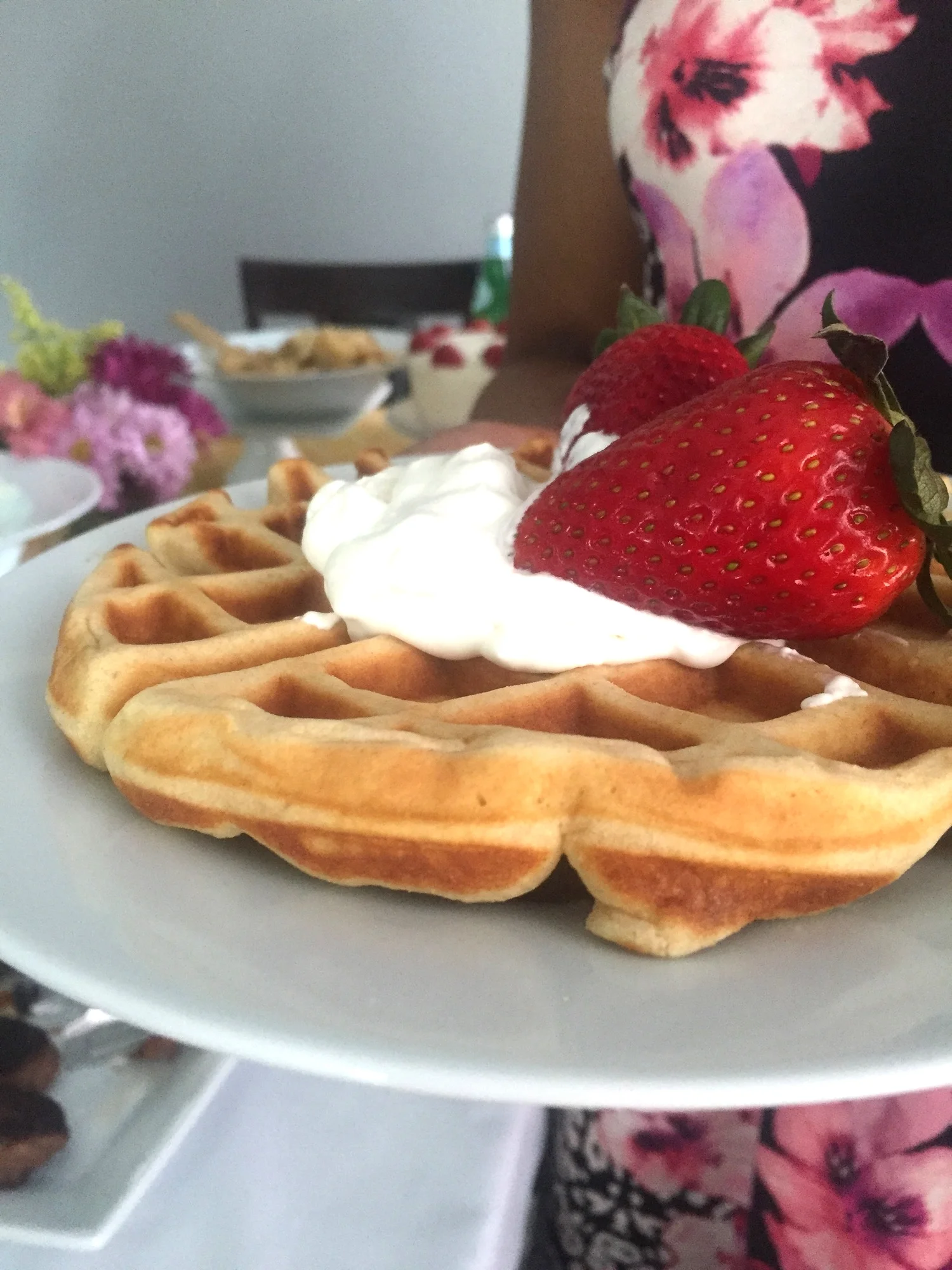Easy Homemade Chicken Stock
Sometime last year, I became really uncomfortable with canned goods. I’d been in the process of “healthy-fying” the contents of my refrigerator and pantry, replacing my standard eggs with cage free ones, dumping the standard milk for organic, etc. I finally reached the cabinet stacked with cans upon cans of beans, tomato paste, and chicken broth and thought to myself, “Hey self. How can you make this stuff better?”
I’m not neurotic about grass fed beef and organic produce. I’m just interested in feeding my family things that aren’t ridden with unnecessary pesticides and preservatives. Forget convenience. I started making beans in bulk and freezing them, and stopped buying them in cans. I switched to organic tomato sauce and paste. And I started making my own chicken and beef stock.
Initially, it seemed a little intimidating, but after making my first batch I’ve never turned back. I use chicken broth in so many recipes, and it just makes so much more sense both in the interest of my family’s health and our grocery budget. At about a dollar a can, I was spending so much on those cans of chicken and beef stock! Dollars that have since been better spent on other awesome food things. Now every few weeks I just cook up a quick batch of stock, and always have it on hand.
What You’ll Need:
A 4-6 quart stockpot (or the largest one you can get your hands on)
Leftover chicken bones or pieces
Three large carrots, cut into thirds
Three large onions
Three celery stalks
Two or three garlic cloves
Two tablespoons of vinegar (preferably cider, but white works fine)
Water
A couple of bay leaves
Sprinkling of peppercorns (optional)
What To Do:
First, prep your vegetables. Rinse and chop your celery stalks and carrots into thirds. Peel and quarter your onions. Peel and smash your garlic cloves. Toss the prepared vegetables and chicken pieces/bones in the pot.
Add your bay leaves and peppercorns, then vinegar, then water. Bring the pot to a boil over high heat. Once it reaches a boil, reduce to a simmer and cover. Let the pot simmer for at least an hour, but you can let it go for up to three. The longer it simmers, the more developed the flavor of your stock.
Once you’ve had enough simmering, let the pot cool for about half an hour. Strain the stock into large plastic containers, and allow to cool before refrigerating. When I sometimes make way too much, I transfer to plastic freezer bags and toss them in the freezer. They’re good there for about six months.
Tips:
- After having a roast chicken for dinner, reserve the backbone or any other pieces that haven’t been chewed or nibbled on. Collect them in a freezer safe bag for when you’re ready to make a batch.
- Chicken gizzards or the innards can work in a pinch, although using pieces as well as bones make for a more flavorful, well-developed stock, so try to at least include some type of bone. Also, roasting the bones before using them in the stock result in a deeper flavor, just takes a few extra minutes!
- Once the stock is cooled and refrigerated, a layer of fat will solidify and settle on the top of the stock. It doesn’t look very pretty, but unless you’re using the entirety of the stock in the next several days, I wouldn’t scoop it off or discard. The fat layer on top helps preserve the stock for longer in your refrigerator. When measuring out your stock for recipes, just don’t use the solidified fat.
Sweet Potato Banana Bread
Since ushering a little life into the world, sweet potatoes have become a staple in our household. Apparently, they’re one of the most nutrient rich, easy to digest foods for babies who are just starting to explore table food. So sweet potatoes it is, all around! Sweet potato pancakes, mashed sweet potatoes, sweet potato breakfast hash, and my most recent development – sweet potato banana bread. For anyone who loves classic banana bread, this spin kicks it up a notch. You still get the magic of banana bread, with the beautiful color and sweet undertone of the sweet potato.
Also, using a root vegetable puree is a fab way to incorporate beautiful moisture and color into whatever you’re making. One day I’ll bake something using beets, since I’m a hundred percent sure it’s equally as fabulous. Most importantly, this is a super easy recipe that just works for those three leftover overripe bananas in the bunch. We all know no one’s going to eat them. Bake them!
What You'll Need:
One or two very ripe bananas
One medium to large sweet potato
Two eggs
½ cup vegetable or canola oil
¼ milk
1¾ cups of flour
1¼ cups sugar
Two teaspoons baking soda
A teaspoon of good vanilla extract
Two teaspoons of cinnamon
A teaspoon of nutmeg
½ teaspoon clove
½ teaspoon allspice
Just a pinch of salt
What To Do:
Preheat your oven to 350 degrees, and prepare your banana and sweet potato puree. Peel, cube, and dice your sweet potato and boil until softened and easily pierced with a fork, drain water. Mash the cooled sweet potato and banana together until only small clumps remain. Add wet ingredients and and mix well (milk, oil, eggs, and vanilla). Once well combined, mix in the sugar.
In a separate bowl, combine the rest of the dry ingredients (flour, baking soda, and spices). Add the dry ingredients into the wet mixture, stirring until just combined. Pour the mixture into a loaf pan that you’ve sprayed well with baking spray. Shake the pan it around a little to make sure everything’s all settled. I like to give it one good loud plop on my countertop, which always scares the dogs, but reassures me that it’s oven ready.
Place your loaf pan in the oven and allow it to bake for an hour. In reality you’re supposed to check the bread with a skewer or toothpick and make sure it comes out clean, but I have a really obnoxious habit of just sticking a butter knife right into the middle. Same effect. Just leaves a kind of annoying stab wound in the middle of your bread. If your skewer (or butter knife) comes out wet, just place back in the oven for five minute intervals until it comes out clean. That’s it. Enjoy!
Dreamy Buttermilk Garlic Mashed Potatoes
In my nearly twenty-six years of life, I’ve learned a few important lessons. I’ve learned to pay my cable bill on time, because a night without Internet is like a night without oxygen. I’ve learned to kiss up to your boss, because even if they’re an asshole, they hold your immediate future in their hands. But most importantly, I’ve learned that mashed potatoes are the most important food in the world, and deserve our utmost respect and benevolence. What’s a holiday table without a platter of fluffy mashed potatoes? It’s blasphemy. In my opinion, they’re the perfect complement to any special dinner. Any meal really.
The key to perfectly fluffy mashed potatoes is not to cook them for too long so they aren’t water logged and heavy, and to use room temperature ingredients while cooking to ensure everything blends together easily. There’s never any excuse to use the instant masked potatoes in a box- that too, is blasphemy. These fluffy miracles are beyond easy to prepare, can be made well in advance, and store and reheat well as leftovers. Follow these steps to achieve mashed potato nirvana.
What You'll Need:
A bunch of clean, scrubbed potatoes. Red skin or yukon gold are ideal, but plain old russets work too. Ten or so small potatoes, or six or so large ones yields about four servings.
About a clove of minced garlic (or a tablespoon of the pre-minced stuff)
3-4 tablespoons of butter
3/4 cup buttermilk
1/2 cup heavy cream, milk, or half and half
Salt to taste
What To Do:
Give your potatoes a good scrub under running water. There's nothing worse than dirt in your mashed potatoes. Goodness no. But no need to dry them off, they're going right in a pot of water.
Dice the potatoes into quarters and place them in nice sized pot of water. Make sure there's at least two inches of water covering them, and bring the pot to a boil. I find that placing the potatoes in the water and bringing them a boil together makes for a better mash, as the potatoes gradually heat instead of being shocked by boiling hot water.
After about twenty minutes, once the potatoes have softened, and are easily pierced with a fork, drain the water. You're left with perfectly soft potatoes, ready to be mashed! Here's the fun part.
Dump the minced garlic and butter onto the steaming potatoes. Grab a potato masher and give them a rough mash. Add the buttermilk and heavy cream, and continue mashing to your desired consistency. I like a chunkier mash. Boyfriend likes smoother. We meet somewhere in the middle. Add salt to taste.
Top them with awesome things. Maybe just butter, maybe chopped chives, or maybe my personal favorite- gravy. We'll get to a gravy post later. Until then- happy eating!
The haute in domestic
This is a block field
You can put any content in here.
Etiam porta sem malesuada magna mollis euismod. Vestibulum id ligula porta felis











